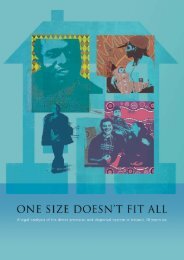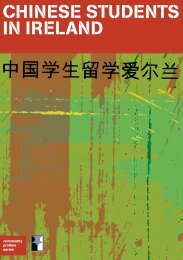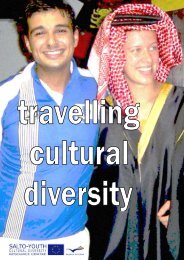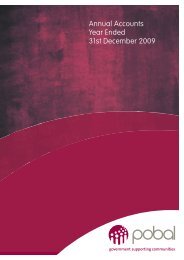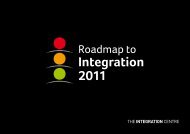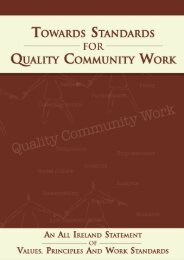Intercultural Education in the Post-Primary School - National Council ...
Intercultural Education in the Post-Primary School - National Council ...
Intercultural Education in the Post-Primary School - National Council ...
You also want an ePaper? Increase the reach of your titles
YUMPU automatically turns print PDFs into web optimized ePapers that Google loves.
IDENTITY AND BELONGINGChildren have a right to understand andparticipate <strong>in</strong> <strong>the</strong> diverse cultural,l<strong>in</strong>guistic, social and artistic expressions ofIrishness. The recognition of <strong>the</strong>contribution of different communities to<strong>the</strong> richness of diversity <strong>in</strong> contemporaryIreland is identified as a key learn<strong>in</strong>g aimof <strong>the</strong> curriculum. This recognises thatdiversity is a characteristic of <strong>the</strong> groupswho can be regarded as ‘belong<strong>in</strong>g’ <strong>in</strong>Ireland. As was stated <strong>in</strong> Chapter 1, this istrue of both historic and contemporaryIreland. This recognition may mean, <strong>in</strong>practice, <strong>the</strong> exploration of <strong>the</strong> broadspectrum of Irish culture <strong>in</strong> Irish, English,and, <strong>in</strong>creas<strong>in</strong>gly <strong>in</strong> o<strong>the</strong>r languages also.For junior-cycle students, becom<strong>in</strong>g awareof <strong>the</strong> concepts on which our nationalpolitical culture is based (justice,democracy, equality, rights, etc.), will be animportant part of com<strong>in</strong>g to make sense of<strong>the</strong>ir identity, historically and at <strong>the</strong>present time.Similarly, <strong>the</strong> l<strong>in</strong>ks with European cultureand a balanced and <strong>in</strong>formed awareness of<strong>the</strong> diversity of peoples and environments<strong>in</strong> <strong>the</strong> world is also identified as a key issue<strong>in</strong> post-primary education. Such awarenesscontributes to young people’s personal andsocial development as citizens of an<strong>in</strong>tercultural Ireland, Europe and <strong>the</strong> globalcommunity. Recognition of <strong>the</strong> l<strong>in</strong>ksbetween Irish cultures and languages and<strong>the</strong> cultures and languages of o<strong>the</strong>rEuropean countries (for example, <strong>the</strong> l<strong>in</strong>ksbetween Gaeilge, Welsh, Breton and ScotsGaelic) will enable <strong>the</strong> student to develop astrong positive sense of national identitywithout this be<strong>in</strong>g seen as hostile to o<strong>the</strong>ridentities.The development of a positive sense of selfis central to <strong>in</strong>tercultural education, and<strong>in</strong>deed to education generally. Members ofm<strong>in</strong>ority ethnic groups who arediscrim<strong>in</strong>ated aga<strong>in</strong>st, or whose cultureand way of life is not represented asnormal or typical <strong>in</strong> <strong>the</strong>ir environment,may be <strong>in</strong> danger of develop<strong>in</strong>g a lowsense of self-esteem or of wish<strong>in</strong>g to deny<strong>the</strong>ir cultural or physical heritage. Forexample, some Traveller children may wishnot be identified as Travellers due to <strong>the</strong>negative images of Travellers to which <strong>the</strong>yhave been exposed while some blackchildren may develop negative attitudes to<strong>the</strong>ir sk<strong>in</strong> colour due to <strong>the</strong> preponderanceof white people <strong>in</strong> our culture’srepresentations of beauty. There is also adanger for members of <strong>the</strong> majority ethnicgroup that <strong>the</strong>ir sense of self-esteem maybecome tied to a sense of <strong>the</strong>ir culture’snormality or superiority. For youngchildren this sense of self-esteem will bedeveloped through a grow<strong>in</strong>g awareness of<strong>the</strong>ir physical and cultural attributes (<strong>the</strong>irhome culture, <strong>the</strong>ir sk<strong>in</strong> colour, etc.), and asense that <strong>the</strong>ir own attributes and those ofo<strong>the</strong>rs are equally valuable. This positivesense of self as an <strong>in</strong>dividual, as a memberof a cultural or ethnic group, and as amember of an <strong>in</strong>tercultural society will befur<strong>the</strong>r developed <strong>in</strong> all childrenthroughout <strong>the</strong>ir school<strong>in</strong>g.52<strong>Intercultural</strong> <strong>Education</strong> <strong>in</strong> <strong>the</strong> <strong>Post</strong>-<strong>Primary</strong> <strong>School</strong>








